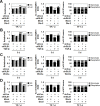Dlx-2 and glutaminase upregulate epithelial-mesenchymal transition and glycolytic switch
- PMID: 26771232
- PMCID: PMC4884964
- DOI: 10.18632/oncotarget.6879
Dlx-2 and glutaminase upregulate epithelial-mesenchymal transition and glycolytic switch
Abstract
Most cancer cells depend on enhanced glucose and glutamine (Gln) metabolism for growth and survival. Oncogenic metabolism provides biosynthetic precursors for nucleotides, lipids, and amino acids; however, its specific roles in tumor progression are largely unknown. We previously showed that distal-less homeobox-2 (Dlx-2), a homeodomain transcription factor involved in embryonic and tumor development, induces glycolytic switch and epithelial-mesenchymal transition (EMT) by inducing Snail expression. Here we show that Dlx-2 also induces the expression of the crucial Gln metabolism enzyme glutaminase (GLS1), which converts Gln to glutamate. TGF-β and Wnt induced GLS1 expression in a Dlx-2-dependent manner. GLS1 shRNA (shGLS1) suppressed in vivo tumor metastasis and growth. Inhibition of Gln metabolism by shGLS1, Gln deprivation, and Gln metabolism inhibitors (DON, 968 and BPTES) prevented Dlx-2-, TGF-β-, Wnt-, and Snail-induced EMT and glycolytic switch. Finally, shDlx-2 and Gln metabolism inhibition decreased Snail mRNA levels through p53-dependent upregulation of Snail-targeting microRNAs. These results demonstrate that the Dlx-2/GLS1/Gln metabolism axis is an important regulator of TGF-β/Wnt-induced, Snail-dependent EMT, metastasis, and glycolytic switch.
Keywords: Dlx-2; GLS1; Snail; epithelial-mesenchymal transition; glycolytic switch.
Conflict of interest statement
The authors declare no conflicts of interest.
Figures






Similar articles
-
Dlx-2 is implicated in TGF-β- and Wnt-induced epithelial-mesenchymal, glycolytic switch, and mitochondrial repression by Snail activation.Int J Oncol. 2015 Apr;46(4):1768-80. doi: 10.3892/ijo.2015.2874. Epub 2015 Feb 4. Int J Oncol. 2015. PMID: 25651912
-
Reactive oxygen species induce epithelial‑mesenchymal transition, glycolytic switch, and mitochondrial repression through the Dlx‑2/Snail signaling pathways in MCF‑7 cells.Mol Med Rep. 2019 Sep;20(3):2339-2346. doi: 10.3892/mmr.2019.10466. Epub 2019 Jul 3. Mol Med Rep. 2019. PMID: 31322179
-
Coexpression of gene Oct4 and Nanog initiates stem cell characteristics in hepatocellular carcinoma and promotes epithelial-mesenchymal transition through activation of Stat3/Snail signaling.J Hematol Oncol. 2015 Mar 11;8:23. doi: 10.1186/s13045-015-0119-3. J Hematol Oncol. 2015. PMID: 25879771 Free PMC article.
-
Oncogenic Metabolism Acts as a Prerequisite Step for Induction of Cancer Metastasis and Cancer Stem Cell Phenotype.Oxid Med Cell Longev. 2018 Dec 23;2018:1027453. doi: 10.1155/2018/1027453. eCollection 2018. Oxid Med Cell Longev. 2018. PMID: 30671168 Free PMC article. Review.
-
Targeting GLS1 to cancer therapy through glutamine metabolism.Clin Transl Oncol. 2021 Nov;23(11):2253-2268. doi: 10.1007/s12094-021-02645-2. Epub 2021 May 23. Clin Transl Oncol. 2021. PMID: 34023970 Review.
Cited by
-
The Warburg Effect 97 Years after Its Discovery.Cancers (Basel). 2020 Sep 30;12(10):2819. doi: 10.3390/cancers12102819. Cancers (Basel). 2020. PMID: 33008042 Free PMC article. Review.
-
Spermine attenuates TGF-β-induced EMT by downregulating fibronectin.J Biol Chem. 2025 Apr;301(4):108352. doi: 10.1016/j.jbc.2025.108352. Epub 2025 Feb 25. J Biol Chem. 2025. PMID: 40015634 Free PMC article.
-
The Epithelial to Mesenchymal Transition Promotes Glutamine Independence by Suppressing GLS2 Expression.Cancers (Basel). 2019 Oct 22;11(10):1610. doi: 10.3390/cancers11101610. Cancers (Basel). 2019. PMID: 31652551 Free PMC article.
-
Effects of Dlx2 overexpression on the genes associated with the maxillary process in the early mouse embryo.Front Genet. 2023 Feb 20;14:1085263. doi: 10.3389/fgene.2023.1085263. eCollection 2023. Front Genet. 2023. PMID: 36891149 Free PMC article.
-
TGF-β-dependent reprogramming of amino acid metabolism induces epithelial-mesenchymal transition in non-small cell lung cancers.Commun Biol. 2021 Jun 24;4(1):782. doi: 10.1038/s42003-021-02323-7. Commun Biol. 2021. PMID: 34168290 Free PMC article.
References
Publication types
MeSH terms
Substances
LinkOut - more resources
Full Text Sources
Other Literature Sources
Molecular Biology Databases
Research Materials
Miscellaneous

